Thursday, November 15, 2012
Mark and Gaz
The first star I see tonight...
Or rather the first plant I tend to see whenever I step into the garden because it is so bright...
I have been meaning to feature this plant for quite some time now, but like anything else that got side stepped for some reason, never seemed able to until I had a quick wander down the garden earlier today and spotted this plant again, like I always do over and over again. So I thought I should actually take the time now and write this long overdue blog post, which is an homage to this beautiful plant.
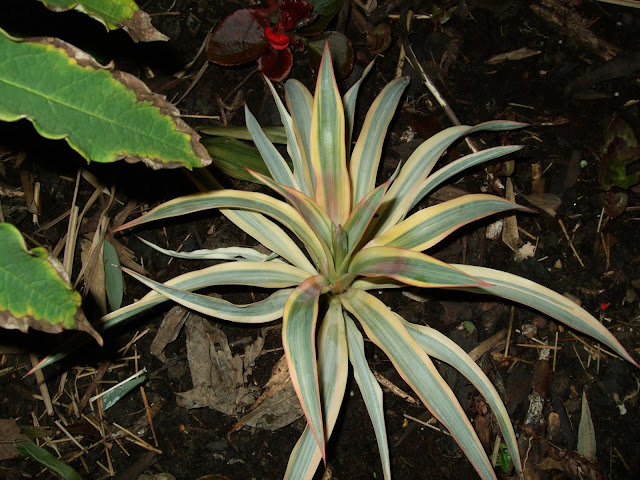 |
| The original plant I bought from CGF - Yucca gloriosa 'Bright Star' |
I first spotted this inside one of the polytunnels of CGF back in 2009 and there it was, a Yucca that shines so brightly on the bench and quite unlike any other variegated yucca I've seen before. There were only two then so I felt fortunate enough to be there at the right time to nab one of the two of what was then a very rare plant. It wasn't the rarity that appealed to me, it was simply for what it looked like; bright, iridescent yellow leaves with a matte texture, the habit and elegance of its species which is gloriosa, and hints of pink and red on certain parts of the leaves, lovely!
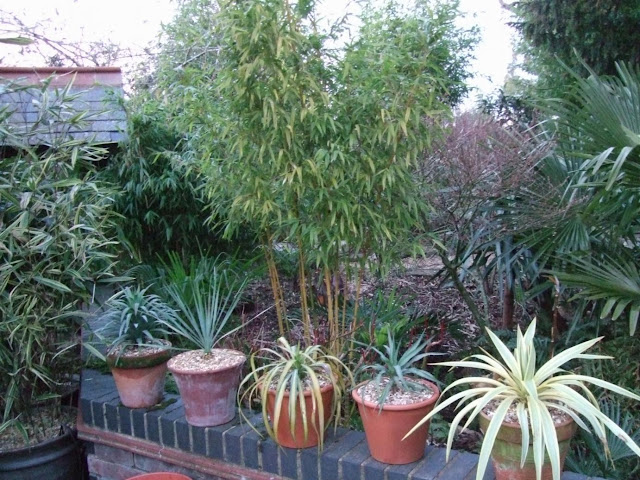 |
| Looking bright, even on a grey winter's day |
So there it was, a new plant to me, and then there was also the question: Will it be hardy? I was sure it would be, it is a variety of the tried and long tested Yucca gloriosa after all. But one must not always assume...
Then much later on in the latter part of 2010 we spotted rows and rows of it at a nearby general garden centre. And it came in two different sizes too, complete with shiny new tags implying that it is new on the market and belonging to a 'trendy range of plants fit for a contemporary garden'. Looks like the tissue culture industry has been successful in propagating this plant and that there will be plenty available to supply garden centres all over. So from rare to definitely not rare any more. Not that it mattered anyway, I was actually happy to see that there were plenty available and we could have more than one for our garden if we choose to. However, with the shiny labels came hefty price tags, much more than I was prepared to pay. The winter months were still about to come then and didn't want to add more plants to overwinter ourselves. And besides, as there were plenty I'm sure they wouldn't sell out by the time spring comes. So we went away without buying any.
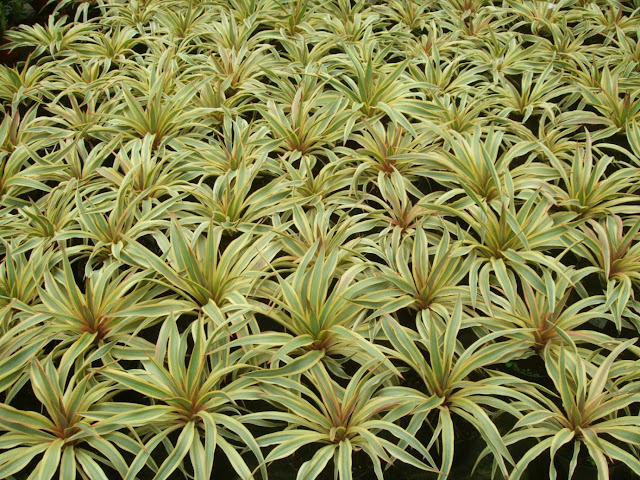 |
| A tissue culture success story... |
And that turned out to be a really good decision for what followed afterwards was the memorable winter of 2010-2011. Just before Christmas we popped round the same garden centre to pick up a few gifts and saw all of the yuccas out in the open and covered by a thick layer of snow. And on another visit just after the New Year they were still covered in snow even though the temperatures had turned slightly warmer (albeit not warm enough to melt all of the snow instantly, hence the white stuff lingered on everywhere for quite some time).
By early April, as we visited the garden centre again in preparation for the spring, there they were, the same lot of yuccas in exactly the same position as they were. But this time half of them were dead, with the spears pulled and rotted down to virtually a tiny stump. But the other half were alive, and not just alive but also looking pristine like they had never even experienced winter at all. And even better, those that were alive were marked down in price to 50% off. Bargain! So I bought two, one small and one of the larger ones.
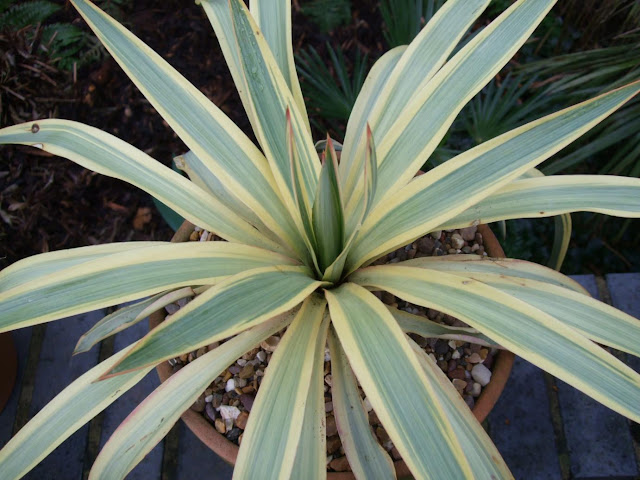 |
| The small survivor... |
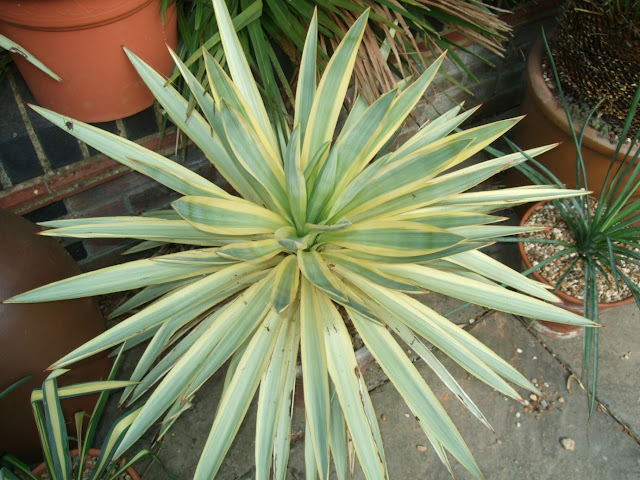 |
| And the bigger one |
So is it hardy? I reckon so. The ones bought in that garden centre have been through a tough winter and sailed through fine, so as expected they were fine through last winter. So how come that batch had a fifty percent casualty? Well in my opinion I wouldn't put that with the ultimate hardiness of this plant but rather as a result of the erratic nature of new plants that were produced en masse via tissue culture. Tissue culture is good, it is an efficient way of propagating plants and ensures that supplies of desirable plants meets demands. It does however has its fair share of aberrations and unpredictability of the performance of the plants that were produced from it (not always as good as the original material where they all came from). So what is the scientific explanation behind it all? Ha! I better leave it as that, as this blog is not the right sort of place to explain such things....
Anyway, fast track to this year I have seen this yucca for sale in virtually every garden centre we have visited so far, including plant fairs and other nurseries (who augment their self propagated stocks by buying a few liners of tissue cultured plants). But despite their presence in left, right, and centre, the appeal to me has never diminished and still find myself gravitating towards them whenever I see them.
However, as much as I like them for their 'in your face' brightness, it is also this brightness that gives them a disadvantage for this plant is very difficult to place in the garden. It is difficult to blend in with existing colour schemes as it is always bound to stand out, nor is it easy to use as a complement with other plants, being bound to overwhelm all others by its brightness. As a plant for a focal point I think it will be effective. And what about planting several instead of just one? I think that will be effective too
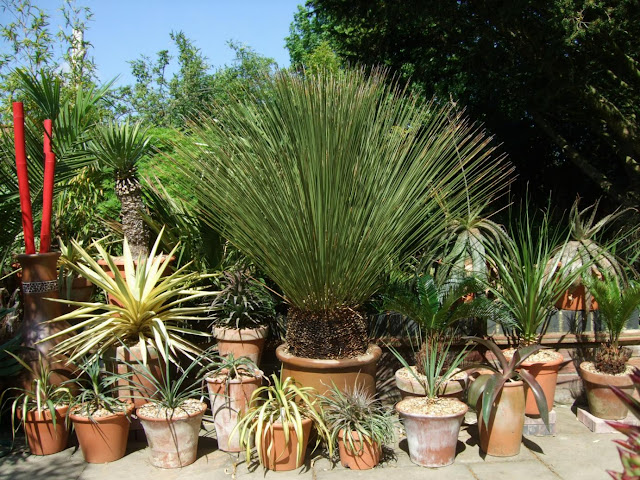 |
| It will stand out anywhere you place it. Can you spot where it is in this picture?? |
Personally it doesn't bother me and just happy enough to see it shining brightly on the patio, standing out from the other yuccas and plants beside it. Perhaps I may even buy a few more, especially once the sales start in the run up to Christmas (and more after it).
What I would like to achieve eventually is to have several trunked specimens, preferably solitary spheres on top of a single trunk. That will look nice with a lot more height to it, with a look similar to that of trunked Cordyline australis 'Torbay Dazzler', only this time with stiffer leaves and significantly much hardier.
As for cultural requirements, it seems just as unfussy as its species Yucca gloriosa and its more commonly found variegated form Yucca gloriosa 'Variegata'. It's a bit vague and general I know but personally I prefer not to give out rules with regards to cultural requirements of most plants, preferring to only mention hints or tips. With regards to the pink blush, this seems induced by various types of harmless stress like being exposed to full sun or in times of cold during the depths or winter. Or even with the new flush of growth during spring.
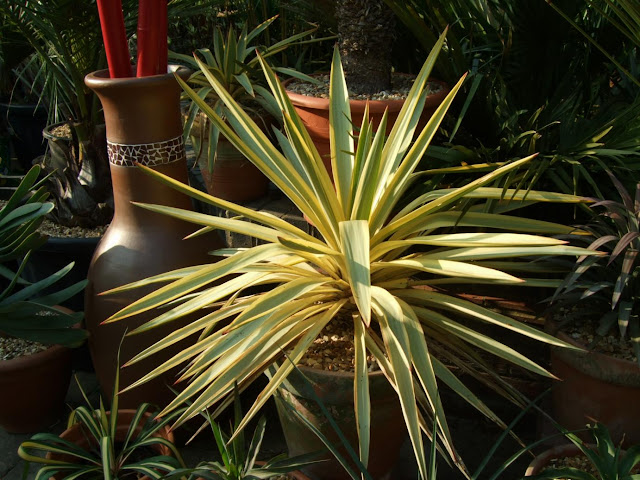 |
| Yucca gloriosa 'Bright Star' |
My tendency to gravitate towards this Yucca is also a reflection of general liking towards variegated yuccas in general, and would love to collect them all given the space and chance. There are a few more out there available, especially in the US and would definitely love to get hold of them in the near future. If tissue culture and mass propping would be the way to go for them to make its way here and make it easier for other gardeners to get hold of them then I'd say bring it on! Who says one has to be rare in order to be desirable? Not me at least.
Mark :-)

Email This
BlogThis!
Share to X
Share to Facebook
Share to Pinterest







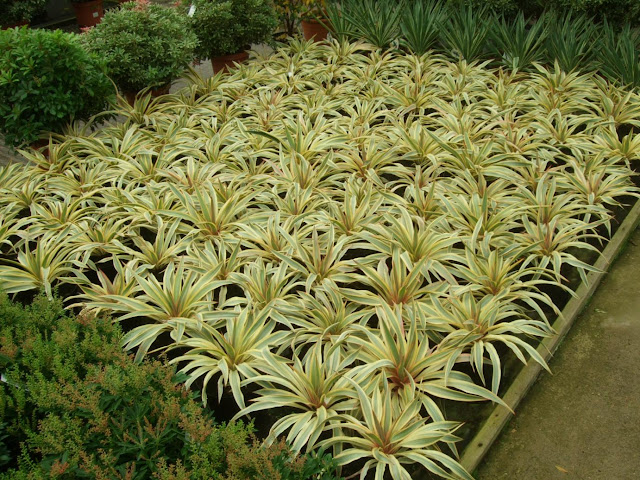

 This gardening blog follows our journey as we create our Tropical and Exotic themed garden. We hope you'll enjoy the journey as much as we do. We started our Exotic Garden in 2005 and this site will show its development, as well as our travels, both abroad and within the UK to gardens, nurseries and friends.
This gardening blog follows our journey as we create our Tropical and Exotic themed garden. We hope you'll enjoy the journey as much as we do. We started our Exotic Garden in 2005 and this site will show its development, as well as our travels, both abroad and within the UK to gardens, nurseries and friends.














Just beautiful! The big question is: Why haven't I bought one yet? I will certainly remedy that this coming spring :-).
ReplyDeleteYes why haven't you got one yet Gerhard! Look forward to spotting one in your garden in the spring.
DeleteI love that Yucca and it's a big bonus that it's evergreen for you. I like things that also give Winter structure to the garden.
ReplyDeleteCher Sunray Gardens
Its a great plant, glad you like it too.
DeleteAbsolutely superb plant! Gorgeous pics of too. a great post
ReplyDeleteHi Deanne, thank you glad you enjoyed the plant and the post :)
DeleteSuperb plant and Article Mark. I have always had severe problems with variegates as like you I find them too difficult to place.
ReplyDeleteI'm sure you could find a spot for one or two of these Don!
DeleteThis is also one of my favorite plants! The first year they were on the market, I spotted them at several nurseries but lately they seem to be pretty scarce around here. I'm glad I got mine when I did!
ReplyDeleteInteresting to hear they are scarce near you, well done for grabbing one while you had chance.
DeleteMy first thought was "You guys too!? Why can everyone grow this beautiful plant that I've had no luck with." But then your story about the garden center and their casualty rate made me feel better. Maybe there is something to my theory of their being weaknesses in the plant.
ReplyDeleteOkay that's it...you've convinced me to try again!
Definitely worth another try again Loree, don't give up just yet :) It can be a bit finicky, just a matter of luck sometimes that you'll get one that actually do well.
DeleteYes - its a great plant! When I wrote my shrub book a couple of years ago I highlighted it in my 'Thirty new and wonderful shrubs' chapter. Eventually it should have the typical spectacular spikes of flowers typical to most Yuccas but in this case the white flowers emerge from deep pink buds which is not as gaudy as it sounds, as there are touches of pink in the leaf bases anyway. I have it in my front garden in Nottingham and hope its still there when I get home in February!
ReplyDeleteGlad to hear that Ian! If you get the chance once you get back in the country do take a pic and feature it on your blog, it'll be interesting to see it :)
DeleteWow, that is truly a special plant! Never seen a yucca like that. It certainly stands out as a specimen plant! Your remarks about tissue culture made me curious to know more about it. Since you are not giving any more secrets away here on your blog, I guess I have to do my own research ;-)!
ReplyDeleteChristina
Hi Christina, if you get the chance do get one, more likely it will do well in your garden :) I don't know much about the very details of TC, just the basics but it is a fascinating subject to read more about.
DeleteWow and doesn't look gorgeous in mass? Beautiful.
ReplyDeleteIt is indeed :) Quite dramatic huddled together like that
DeleteWhen so many yucca plants are placed together, they look like pineapple plants.
ReplyDeleteGood observation Autumn Belle, they do look like variegated pineapple plants :)
DeleteWhat a shiny plant. I know CGF rely heavily on tissue culture for their propagation, I had to tell them once that they could propagate something bby root cuttings and they were surprised. Makes you wonder really they might be good at identify new plants etc but surely a good plantsman wouldn't rely solely on tissue culture
ReplyDeleteHi Helen, a lot off their plants certainly does come via tissue culture, I think it's a huge arm of their business as well, supplying TC plants to other nurseries. Perhaps the staff present at that time are not that knowledgeable with plants and propagation.
DeleteThanks for spinning such a nice tale about a notable plant. Blown away by the tissue culture plants. Will have to keep my eye out for it around here. Thanks, guys.
ReplyDeleteGood luck in finding one Patrick, although it shouldn't be too hard hopefully.
DeleteWow, now I want one too! What a beautiful succulent! Thanks for the introduction!
ReplyDeleteHi Candice, glad you like it, I hope you can track one down.
DeleteWow, that really packs a punch, as you say, hard to combine with other plants but great as a focal point. And I completely agree about a plant not needing to be rare to be desirable. Its easy to get snobby, but all I really care about is whether I like a plant or not, and whether it will grow well and combine well in my situation.
ReplyDeleteHi Janet, a more relaxed attitude like is the way to go most of the time :) Pretty to ones eyes and not too mindful about what others think!
DeleteYes it's one of my favorites as well. Oh how I hope mine will offset!
ReplyDeletea very shiny plant. I hope my little one will become so nice
ReplyDeleteLove it by the pool and the tissue culture images are stunning. Has it bloomed yet?
ReplyDelete